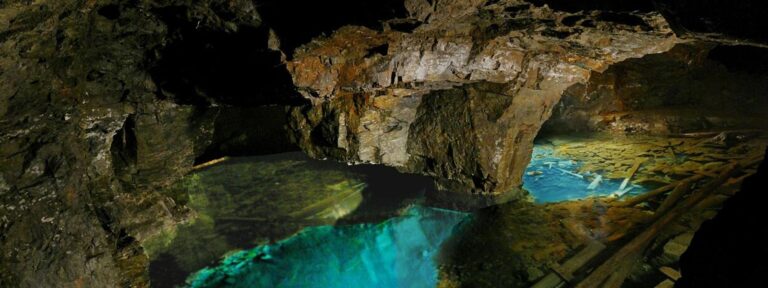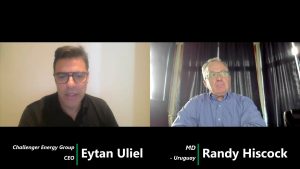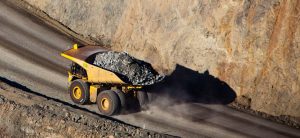European Metals Holdings Ltd (LON:EMH) have today announced analytical results for two drillholes from the recently completed drilling in the Cinovec Main sector of the deposit. These results confirmed or exceeded the expected lithium content and mineralisation widths.
In addition, the Cinovec South Resource has now been added to the Czech State resource register. This is the first step in the process for the granting of a mining permit. DirectorsTalk caught up with Keith Coughlan to discuss todays news. You can listen to the interview here.
Key Points:
· Hole CIW-22 contains the best lithium intercept to-date from the Company’s drill programme of 264.5 m averaging 0.54% Li2O.
· This hole also contains significant tungsten, tin, niobium and tantalum mineralization. For example, the best interval between 238m to 240m averages 0.86% Li2O, 0.41% Sn, 2.92% W, 868ppm Nb, 150ppm Ta. The tungsten grade in particular was significantly higher than expected.
· Hole CIW-26 returned an interval of 236.25m averaging 0.49%Li2O (including high-grade intervals 16m@0.99%Li2O, 3m@1.15% Li2O, 2m@1.34% Li2O, 2m@0.99% Li2O, 1.3m@1.72% Li2O, 2m@0.93% Li2O, 5m@0.84% Li2O.
· Drillhole CIW-26 is located at the western edge of the deposit near the contact of the mineralisation. Drillhole CIW-22 is located in the central part of Cinovec Main.
· All remaining analytical results from the program will be released next week.
· Geological information from all 17 drillholes has been compiled into the Cinovec database and serves to update the geological model for Cinovec Main. The geologic model will be used to constrain and update the current block model. The block model will be updated in early February when all analyses will be available. The block model and resource calculation will be part of the Pre-Feasibility Study.
European Metals Holdings Ltd CEO Keith Coughlan said: “I am pleased to report results from two additional drillholes from the recently completed drilling program at Cinovec Main. These results are excellent in terms of lithium grades and length of mineralised intervals. An unexpected bonus is a high-grade zone of tungsten, intersected by drillhole CIW-22 at 238 meters depth which graded almost 3% of tungsten.
In addition, we are pleased to have been informed that subsequent to a submission we made to the State Authority, the Cinovec South resource estimate was approved by a Committee of Experts and placed on the State Register of mineral deposits. This is a pre-requisite for receiving a mining permit. We already applied for the ‘preliminary mining space’ for Cinovec South, immediately after the resource calculation for Cinovec South was accepted to the State Register.”
Drill Programme
The CIW-22 was collared in the central part of Cinovec main, whereas drillhole CIW-26 was located at the western edge of the Cinovec Main sector of the deposit (see Figure 1).
The current drill programme at Cinovec Main has been planned to confirm and delineate near surface lithium and tin mineralisation that would provide initial feed to the mill. Other goals are the conversion of resources from the Inferred to Indicated category, and delivery of material for metallurgical testing. 17 diamond core holes have been completed. Visual inspection and logging indicates that the geology in these holes is as expected. Drill details are listed in Table 1 below.
After geological logging, drill core is cut by a diamond saw. Quarter core samples are selected (honouring geological boundaries) and dispatched to ALS (Romania) for preparation and assay; the 3/4 of the core is returned to the core box and stored securely on site. Samples are being prepared and analysed by ALS using ICP and XRF techniques following standard industry practice for lithium and tin deposits. Strict QAQC protocols are observed, including the insertion of a Li standard in random fashion for every 10 core samples, as well as the insertion of blank and duplicate samples.
| Table showing the completed drillholes, Cinovec Main | |||||||
| Hole ID | North | East | Elevation (m) | Depth (m) | Azimuth | Dip | Comments |
| CIW-11 | -779300 | -966098 | 867.4 | 444.4 | 40.1 | -77.86 | confirmation/infill |
| CIW-20 | -778811 | -965638 | 837.5 | 257.6 | 336.7 | -84.6 | confirmation/infill |
| CIW-13 | -779176 | -966127 | 862.8 | 429.3 | 76 | -80.4 | confirmation/infill |
| CIW-19 | -778811 | -965692 | 837.8 | 271.6 | 332.1 | -89.58 | confirmation/infill |
| CIW-08 | -778791 | -965800 | 837.6 | 274.9 | 156.85 | -89.3 | confirmation/infill |
| CIW-18 | -779019 | -966183 | 855.47 | 395.7 | 210.6 | -89.05 | confirmation/infill |
| CIW-14 | -779056 | -966093 | 854.46 | 417.8 | 323.3 | -89.07 | confirmation/infill |
| CIW-07 | -778867 | -965841 | 840.99 | 300 | 333.6 | -89.57 | confirmation/infill |
| CIW-26 | -779215 | -965937 | 865.33 | 430.5 | 248 | -89.38 | confirmation/infill |
| CIW-17 | -778957 | -965521 | 847.07 | 238.2 | 332.1 | -89.58 | confirmation/infill |
| CIW-21 | -778812 | -965952 | 841.33 | 320.6 | 42.68 | -89.02 | confirmation/infill |
| CIW-10 | -779215 | -965938 | 865.35 | 455 | 303.4 | -74.47 | confirmation/infill |
| CIW-23 | -779009 | -965994 | 848.91 | 376.1 | 222.3 | -89.4 | confirmation/infill |
| CIW-22 | -779009 | -965993 | 848.88 | 420.6 | 287.9 | -70.43 | confirmation/infill |
| CIW-06 | -778995 | -965845 | 846.77 | 296.3 | 11.7 | -80.18 | confirmation/infill |
| CIW-25 | -778994 | -965902 | 847.04 | 382.4 | 281.1 | -69.89 | confirmation/infill |
| CIW-27 | -779152 | -965817 | 861.5 | 370 | 271.9 | -89.53 | confirmation/infill |
| Hole locations are recorded in the local S-JTSK Krovak grid, all coordinates are surveyed. | |||||||
Mineralised Intercepts and Lithology
The drillhole CIW-26 was located near the granite-porphyry contact, testing lithium mineralisation near the western edge of the deposit. In this location, at the W and NW part of the deposit, the contact is relatively steeply dipping. The CIW-26 drillhole was drilled from the same site as CIW-10 but was vertical.
The drillhole CIW-22 was collared in the central part of the Cinovec-Main deposit where the Cinovec lithium granite daylights, drilled from the same site as CIW-23. CIW-22 was angled -70degree toward West (288 degrees).
CIW-26 started in the overlying barren porphyry. The porphyry-granite contact at 174m drill string depth (DSD) is of tectonic nature. Immediately below the contact a massive greisen was intersected to DSD of 203 meters. The interval between 203m to 296m DSD is dominated by albite granite with zinnwaldite, locally including zones of greisenized granite and greisen. Below, down to DSD of 424m, is a long zone of greisenized granite, underlying by low-mica weakly mineralised granite that forms the base of the lithium mineralization. In CIW-26, very few core angles of contacts were observed. A narrow greisen contact was measured at 27 degrees, and as the core was not oriented, it is impossible to ascertain with certainty the orientation of the mineralised zones. Therefore, the mineralised intercept may not represent true width. The geological model predicts that at the western contact the greisen dip W.
Drillhole CIW-22 starts in granite to DSD of 124m. Interval between 124 and 182m is formed by greisen and greisenised granite, locally with quartz veins. One wider stope after historic mining was intersected. A long interval formed mostly by greisenised granite was intersected between 205m and 382m, confirming the general paradigm of two major greisen zones separated by albite-zinnwaldite granite. The base of the hole is low-mica granite. As usual the contacts are mostly gradational. Core angles of sharper contact are steep at around 60 degrees so the intercept lengths do not represent true widths of mineralisation but are likely reasonably close based on the general geological model. At 238 meters an unusually high grade zone of tungsten was intersected. This interval is formed by a quartz-zinnwaldite greisen with crystals of wolframite, with greisenized granite footwall and hanging wall. Due to relative lack of data is it difficult to assess the orientation of this high grade zone at this time.
The Tables below list the mineralised intercepts for the two drillholes.
| Table summarizing mineralised intercepts in CIW-22 | ||||||
| CIW-22 | ||||||
| From | To | Interval (m) | Li2O (%) | Sn (%) | W (%) | Note |
| 10 | 28 | 18 | 0.22 | |||
| 100 | 119 | 19 | 0.21 | |||
| 123 | 387.5 | 264.5 | 0.54 | incl. 6m@1.17%Li2O (129.5-135.5m), | ||
| 4m@0.92%Li2O (141-145m), | ||||||
| 7m@0.91%Li2O (175-182m), | ||||||
| 2m@1.07%Li2O (256-258m) | ||||||
| 125 | 134.5 | 9.5 | 0.96 | 0.22 | 0.071 | |
| 128.5 | 135.5 | 7 | 1.12 | 0.25 | 0.095 | |
| 141 | 143 | 2 | 1.25 | 0.07 | 0.408 | |
| 160 | 161 | 1 | 0.71 | 0.02 | 0.157 | |
| 167 | 168 | 1 | 0.93 | 0.2 | 0.046 | |
| 175 | 179 | 4 | 0.98 | 0.01 | 0.091 | |
| 234 | 235 | 1 | 0.48 | 0.03 | 0.059 | |
| 238 | 240 | 2 | 0.86 | 0.41 | 2.915 | 868ppm Nb, 150ppm Ta |
| 256 | 257 | 1 | 1.16 | 0.02 | 0.07 | |
| 221 | 252 | 31 | 150ppm Nb | |||
| 286 | 331 | 45 | 104ppm Nb | |||
| Cut-off: 0.2%Li2O, 0.1%Sn, 0.05%W, determining metal for definition of interval in bold | ||||||
| Table summarizing mineralised intercepts in CIW-26 | ||||||
| CIW-26 | ||||||
| From | To | Interval (m) | Li2O (%) | Sn (%) | W (%) | Note |
| 173.75 | 410 | 236.25 | 0.49 | incl. 16m@0.99%Li2O (186-202m), | ||
| 3m@1.15%Li2O (186-189m), | ||||||
| 2m@1.34%Li2O (192-194m), | ||||||
| 2m@0.99%Li2O (246-248m), | ||||||
| 1.3m@1.72%Li2O (253.1-254.4m), | ||||||
| 2m@0.93%Li2O (308-310m), | ||||||
| 5m@0.84%Li2O (369-374m) | ||||||
| 178 | 181 | 3 | 0.7 | 0.01 | 0.111 | |
| 187 | 188 | 1 | 0.84 | 0.11 | 0.003 | |
| 346 | 368 | 22 | 0.45 | 103ppm Nb | ||
| 379 | 423.5 | 44.5 | 0.26 | 111ppm Nb | ||
| Cut-off: 0.2%Li2O, 0.1%Sn, 0.05%W, determining metal for definition of interval in bold | ||||||
(Please refer to the announcement on the European Metals Website for the graphic Figure 1 – A geological map showing the Company’s drill holes (with angled holes traces projected to surface) against surface geology and subsurface greisen bodies projected to surface (in green). Historic UG workings and drill holes not shown – www.europeanmet.com.)
CINOVEC SOUTH RESOURCE ADDED TO CZECH STATE RESOURCE REGISTER
The process for the award of a mining permit commences with the placing of a mineral resource on the State Resource Registry and receiving a certificate of an ‘exclusive mineral deposit’. This is achieved by defending a resource calculation and a preliminary technical and economic analysis proving the studied resource has a quality consistent with a potentially mined deposit. The addition to the State Resource Register means that civic development on top of the area is restricted and it allows the Company to apply for a setting a preliminary mining space, which is a step toward obtaining the final mining permit.
The company is currently working on the submission for the remaining NW part of the orebody and on placing it on the State Resource Registry.
BACKGROUND INFORMATION ON CINOVEC
PROJECT OVERVIEW
Cinovec Lithium/Tin Project
European Metals owns 100% of the Cinovec lithium-tin deposit in the Czech Republic. Cinovec is an historic mine incorporating a significant undeveloped lithium-tin resource with by-product potential including tungsten, rubidium, scandium, niobium and tantalum and potash. Cinovec hosts a globally significant hard rock lithium deposit with a total Indicated Mineral Resource of 232.8 Mt @ 0.45% Li2O and a total Mineral Resource of 606.8 Mt @ 0.43% Li2O containing a combined 6.46 million tonnes Lithium Carbonate Equivalent.
This makes Cinovec the largest lithium deposit in Europe and the fourth largest non-brine deposit in the world.
Within this resource lies one of the largest undeveloped tin deposits in the world, with total Indicated Mineral Resource of 28.6 Mt @ 0.23% Sn and a total Mineral Resource of 70.5 Mt grading 0.20% Sn for a combined total of 141.2 kt of contained tin. The Mineral Resource Estimates have been previously released on 23 November 2016. The deposit has previously had over 400,000 tonnes of ore mined as a trial sub-level open stope underground mining operation.
A Scoping Study conducted by specialist independent consultants indicates the deposit could be amenable to bulk underground mining. Metallurgical test work has produced both battery grade lithium carbonate and high-grade tin concentrate at excellent recoveries with the Scoping Study. Cinovec is centrally located for European end-users and is well serviced by infrastructure, with a sealed road adjacent to the deposit, rail lines located 5 km north and 8 km south of the deposit and an active 22 kV transmission line running to the historic mine. As the deposit lies in an active mining region, it has strong community support.












































